 |
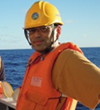 |
|
| Hiroaki Saito | Koji Suzuki |
Kuroshio Ecosystem is highly influenced by the change in the physical and chemical characteristics of the North Pacific subtropical gyre. Hiroaki Saito (FRA) and Koji Suzuki (Hokkaido Univ.) attended the Hakuho-Maru cruise (JAMSTEC) KH11-10 to the subtropical Pacific.
Hakuho-Maru is the flag ship of Japanese Scientific Research vessel (100m long, 3991 ton). Hakuho-Maru left Tokyo on Dec 1 2011 headed off Honolulu. We here report the observations and life on board Hakuho-Maru.
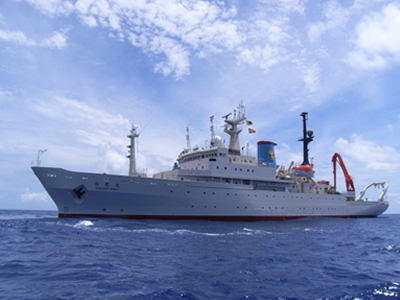

Sampling stations of KH11-10 cruise. Leg1 is from Tokyo to Honolulu. Leg 2 is to El Callao, Peru.
Hakuho-Maru departed from Harumi pier, Tokyo, for Honululu, HI.
 |
 |
CTD(Conductivity, temperature, depth sensor) cast is “fundamental” observation in ocean sciences. We deployed the CTD-NISKIN bottle sampling system to >5000 m (50 m above the bottom) and collected water samples >20 sampling layers.
 |
 |
 |
Water samples are filtered through various types of filter. Suspended particulate matter including plankton and detritus (dead organisms, faecal matter, etc) are collected. We often spent so long hours in front of the water filtering system. This is an important part of biological and chemical oceanographers’ life on board.
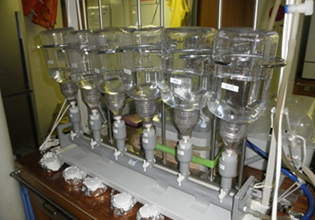 |
 |
|
| One of many water filtering systems | Glass fiber filtering out the plankton and detritus in sea water. Phytoplankton make the filter greenish. Small black or brown particles are microzooplankton, faecal pellet of zooplankton, detritus, etc. |
The principle player in marine ecosystem is “plankton” which is tiny plants and animals without swimming ability. Zooplankton is animals with size range of 0.1-10 mm feeing on smaller phytoplankton (plant). Zooplankton is important prey organisms of fish.
To collect zooplankton, we use various types of “plankton net”. The net is towed from target depth to the sea surface and filter zooplankton larger than the mesh size of the net. VMPS is a special sampler collecting zooplankton from various depth layers by opening and closing 8-plankton nets by depth.
 |
 |
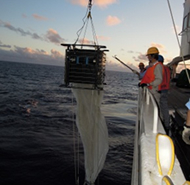 |
||
| Twin-NORPAC net (diameter: 45cm) | ORI-net (diameter: 2m) for larger zooplankton | VMPS (Vertical Multiple-opening Plankton Sampler). |
Only one net tow in the subtropical water, various beautiful zooplankton species are collected.
Copepod is the most abundant group of zooplankton.
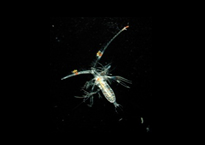 |
 |
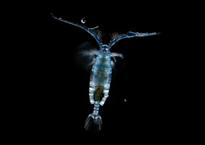 |
||
| Rhincalanus sp. | Calanus jashinovi | Labidocera acuta |
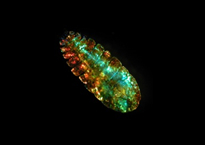 |
 |
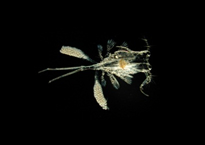 |
||
| Saphirina sp. | Saphirina sp. | Copilia mirabilis |
Crustacean zooplankton is the other dominant group of zooplankton than copepods
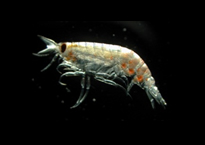 |
 |
 |
||
| Amphipod | Phronima sedentaria |
“Gelatinous zooplankton” have transparent body like jellyfish
 |
 |
 |
||
| Ctenophore | Doliolid | Pterosagitta draco |
There are “planktonic” shellfish. Some species lost their shells (Clione sp.)
 |
 |
 |
||
| Pteopod | Gymnosome |
Western subtropical Pacific is super-oligotrophic (i.e., nutrient deplete) water. Both nitrate and phosphate concentrations are <3nM, which are <1/100 of Japanese coastal water.
 |
 |
|
| CTD sensor beneath the sea surface | Water property observation by means of Biospherical PRR800/810 radiometer |
Due to low concentration of phytoplankton and suspended particulate and dissolved matter, the water is blue and extraordinary transparent. We deployed an underwater spectroradiometer to examine the optical property of the sea water.
On research vessel, observations continue both day and night. It is not unusual situation for us working 24hours a day. Blue sky and beautiful figure of clouds are kinds of refreshment.
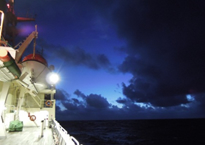 |
 |
 |
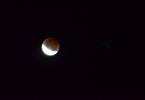
We saw lunar eclipse on Dec. 10.
Hakuho-Maru is approaching to Honolulu harbor under the rainbow!
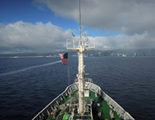 |
 |
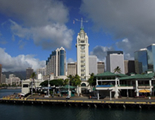 |
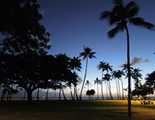 |

Participants of the Hakuho-Maru Cruise















